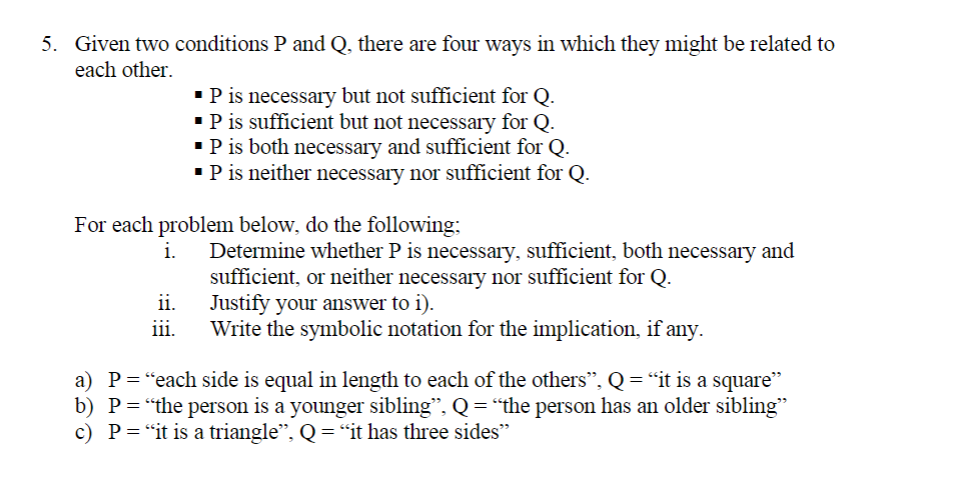5. Given two conditions P and Q, there are four ways in which they might be related to each other. •P is necessary but not sufficient for Q. •P is sufficient but not necessary for Q. •P is both necessary and sufficient for Q. •P is neither necessary nor sufficient for Q. For each problem below, do the following: i. Determine whether P is necessary, sufficient, both necessary and sufficient, or neither necessary nor sufficient for Q. ii. Justify your answer to i). iii. Write the symbolic notation for the implication, if any. a) P="each side is equal in length to each of the others", Q = "it is a square" b) P="the person is a younger sibling", Q = "the person has an older sibling" c) P="it is a triangle", Q = “it has three sides"
5. Given two conditions P and Q, there are four ways in which they might be related to each other. •P is necessary but not sufficient for Q. •P is sufficient but not necessary for Q. •P is both necessary and sufficient for Q. •P is neither necessary nor sufficient for Q. For each problem below, do the following: i. Determine whether P is necessary, sufficient, both necessary and sufficient, or neither necessary nor sufficient for Q. ii. Justify your answer to i). iii. Write the symbolic notation for the implication, if any. a) P="each side is equal in length to each of the others", Q = "it is a square" b) P="the person is a younger sibling", Q = "the person has an older sibling" c) P="it is a triangle", Q = “it has three sides"
Linear Algebra: A Modern Introduction
4th Edition
ISBN:9781285463247
Author:David Poole
Publisher:David Poole
Chapter2: Systems Of Linear Equations
Section2.4: Applications
Problem 33EQ
Related questions
Question
Assume nothing other than what is written

Transcribed Image Text:5. Given two conditions P and Q, there are four ways in which they might be related to
each other.
•P is necessary but not sufficient for Q.
•P is sufficient but not necessary for Q.
•P is both necessary and sufficient for Q.
•P is neither necessary nor sufficient for Q.
For each problem below, do the following;
Determine whether P is necessary, sufficient, both necessary and
sufficient, or neither necessary nor sufficient for Q.
ii.
i.
Justify your answer to i).
Write the symbolic notation for the implication, if any.
iii.
a) P="each side is equal in length to each of the others", Q= "it is a square"
b) P="the person is a younger sibling", Q = "the person has an older sibling"
c) P="it is a triangle", Q =“it has three sides"
Expert Solution
This question has been solved!
Explore an expertly crafted, step-by-step solution for a thorough understanding of key concepts.
This is a popular solution!
Trending now
This is a popular solution!
Step by step
Solved in 2 steps with 2 images

Recommended textbooks for you

Linear Algebra: A Modern Introduction
Algebra
ISBN:
9781285463247
Author:
David Poole
Publisher:
Cengage Learning

Elements Of Modern Algebra
Algebra
ISBN:
9781285463230
Author:
Gilbert, Linda, Jimmie
Publisher:
Cengage Learning,

Algebra: Structure And Method, Book 1
Algebra
ISBN:
9780395977224
Author:
Richard G. Brown, Mary P. Dolciani, Robert H. Sorgenfrey, William L. Cole
Publisher:
McDougal Littell

Linear Algebra: A Modern Introduction
Algebra
ISBN:
9781285463247
Author:
David Poole
Publisher:
Cengage Learning

Elements Of Modern Algebra
Algebra
ISBN:
9781285463230
Author:
Gilbert, Linda, Jimmie
Publisher:
Cengage Learning,

Algebra: Structure And Method, Book 1
Algebra
ISBN:
9780395977224
Author:
Richard G. Brown, Mary P. Dolciani, Robert H. Sorgenfrey, William L. Cole
Publisher:
McDougal Littell

Elementary Geometry For College Students, 7e
Geometry
ISBN:
9781337614085
Author:
Alexander, Daniel C.; Koeberlein, Geralyn M.
Publisher:
Cengage,

Elementary Geometry for College Students
Geometry
ISBN:
9781285195698
Author:
Daniel C. Alexander, Geralyn M. Koeberlein
Publisher:
Cengage Learning

Algebra for College Students
Algebra
ISBN:
9781285195780
Author:
Jerome E. Kaufmann, Karen L. Schwitters
Publisher:
Cengage Learning